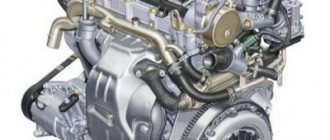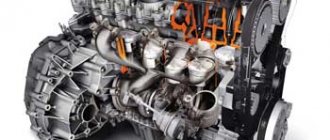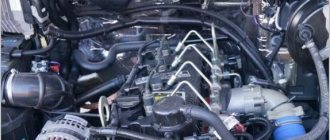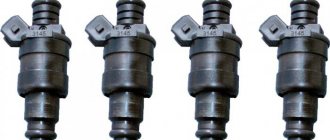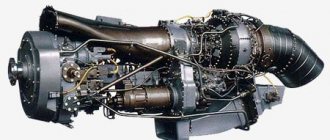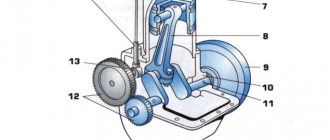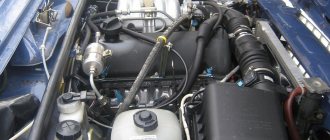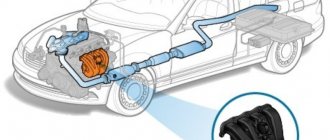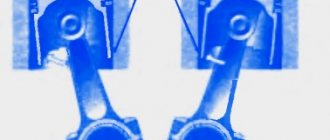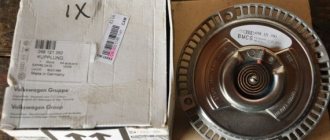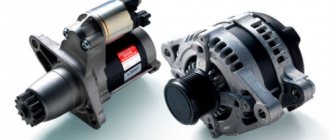The principle of operation of an internal combustion engine is studied at school, but I will still describe it.
First stroke, intake. The piston moves down, the intake valve opens, and the fuel mixture flows from the carburetor into the cylinder. When the piston reaches the bottom position, the intake valve closes.
Read also: Where should valves on cylinders be replaced?
Second stroke, compression. The piston goes up, the fuel mixture is compressed. When the piston is a few millimeters from top dead center (TDC), the spark plug ignites the fuel compressed by the piston.
Third stroke, power stroke (expansion). Once the fuel is ignited, it burns and the hot gases expand rapidly, pushing the piston down (both valves are closed).
Fourth measure, release. By inertia, the crankshaft continues to rotate (for uniform rotation, weights are installed on the crankshaft - crankshaft cheeks), the piston goes up. At the same time, the exhaust valve opens and the exhaust gases exit into the exhaust pipe. When the piston reaches TDC, the exhaust valve closes.
Then all four measures are repeated.
The inventor of the 4-stroke internal combustion engine (as well as the two-stroke engine) was the German Nikolaus August Otto (1832-1891). Therefore, the internal combustion engine is sometimes called the Otto engine.
For reasons of economy, more and more outboard motors are equipped with four-stroke engines. Although these engines, with the same cylinder volume, are inferior in power to two-stroke ones, they have their own advantages:
- fuel efficiency
-the four-stroke engine is quieter and more stable.
Unlike a two-stroke engine, in which the crankshaft, crankshaft bearings, compression rings, piston, piston pin and cylinder are lubricated by adding oil to the fuel; The crankshaft of a four-stroke engine is in an oil bath. Thanks to this, you do not need to mix gasoline with oil or add oil to a special tank (on models of two-stroke outboard engines with a separate lubrication system). It is enough to pour clean gasoline into the fuel tank and you are ready to go, eliminating the need to purchase special oil for 2-stroke engines. Also, significantly less carbon deposits form on the piston mirror and the walls of the muffler and exhaust pipe. In addition, in a 2-stroke engine, the unburnt fuel mixture is released into the water, which is explained by its design.
A drive sprocket is installed on the crankshaft, which ensures (via a chain) rotation of the camshaft located in the cylinder head. This shaft determines when one of the two valves (intake and exhaust valves) should be opened or closed, depending on the position of the piston. The camshaft contains cams that engage the valve rocker arms. (the diagram shows a camshaft)
The rocker arms press on one or another valve, opening it. There must be a gap between the rocker arm adjusting bolt and the valve, the so-called thermal gap. When heated, the metal expands, and if the thermal gap is small or non-existent, the valves will not tightly close the intake or exhaust ports, which is why it is so important to adjust the valve clearance. The exhaust gases are hotter than the fuel mixture, and the exhaust valve heats up (and therefore expands) more than the intake valve. This explains the difference in clearances between the intake and exhaust valves.
Internal combustion engines were supposed to replace the industrial steam engine. However, enthusiasts who worked on the creation of the motor were able to feel the potential that was inherent in it. The inventors managed to find methods that made it possible to significantly increase the power of the unit without a significant increase in weight. So, Nikolaus Otto played one of the main roles in this project.
How Otto developed the engine
The unit, invented by a scientist named Alphonse Beau de Rocha, and then built by the German engineer Nikolaus Otto in 1867, was considered in those years to be the maximum of manufacturability and almost perfection. There were simply no analogues for it. The motor was very inexpensive to operate, had a compact size, and also did not require frequent maintenance.
The operation of the four-stroke engine was built according to a clear algorithm. Today it is called the "Otto cycle". In 1875, Nikolaus Otto in his company produced more than 600 engines per year.
Read also: Bearing how to determine the size
From a four-stroke internal combustion engine to a car
The team of engineers who worked on the creation of the unit included one talented guy - Gottlieb Daimler.
He was then passionate about the idea of creating a real car based on this engine. But Otto did not want to modernize an already successful engine. Daimler was forced to leave the project, but the desire to build a car did not go away.
As a result, together with his friend and like-minded person in 1889, Daimler assembled a car based on a four-stroke gasoline engine operating according to the Otto algorithm.
Difference between a 4-stroke engine and a 2-stroke engine
The internal combustion engine operating cycle consists of several processes that are aimed at obtaining a portion of the force that will act on the crankshaft. This cycle consists of fuel injection, compression, ignition of the fuel mixture, gas expansion, exhaust.
A stroke in an internal combustion engine is one stroke of the piston, either up or down. In a two-stroke engine, one revolution of the crankshaft completes two strokes. When gases expand, the piston does useful work.
Units where the working stroke occurs in two strokes are called push-pull. And if four strokes are completed in two revolutions of the crankshaft, then this is already a four-stroke engine.
Both of them can be either gasoline or diesel fuel. To understand the design and operation features, the differences between different motors, you need to consider the principles of their operation.
How does the starting system work?
Improving the performance of your engine is a big deal, but what's more important is what exactly happens when you turn the key to start it! The starting system consists of a starter with an electric motor. When you turn the ignition key, the starter turns the engine several revolutions so that the combustion process begins its work, and it can only be stopped by turning the key in the opposite direction when the spark stops flowing to the cylinders, and thus the engine stalls.
The starter has a powerful electric motor that rotates a cold internal combustion engine. The starter is always a fairly powerful engine and, therefore, a battery-consuming engine, because it must overcome:
- All internal friction caused by the piston rings and aggravated by cold, unheated oil.
- The compression pressure of any cylinder(s) that occurs during the compression stroke.
- The resistance exerted by the camshaft to open and close the valves.
- All other processes directly related to the engine, including the resistance of the water pump, oil pump, generator, etc.
We see that the starter needs a lot of energy. The car most often uses a 12-volt electrical system, and hundreds of amps of electricity must flow to the starter.
Differences between two-stroke and four-stroke engines
Among the main differences, as already mentioned, is a different gas exchange system.
In a two-stroke engine, both the process of filling the combustion chamber and its cleaning are carried out together with the compression and expansion stroke. For this purpose, the cylinder has special technological holes for the inlet of the mixture and the release of gases. Units with this design do not have a timing mechanism, which makes these motors much simpler and lighter.
Read also: Do-it-yourself scraper for walk-behind tractor
Duty cycle
The sequence of steps looks like this:
- Intake stroke. Due to the rotation of the crankshaft, the piston goes from the highest point to the lowest point, the camshaft cams open the valve to the inlet. The mixture is absorbed through it.
- Compression stroke. The crankshaft pushes the piston up, the intake valve closes, and the exhaust valve remains closed. The temperature and pressure in the cylinder increase.
- Expansion stroke. Before compression is complete, the spark plug ignites the mixture. The fuel burns, the mixture expands and moves the piston. A connecting rod connected to the piston transmits torque to the crankshaft. When gases expand, they do work, so the stroke of the crankshaft is called working. The angle of “underrotation” of the crankshaft, which has not yet brought the piston to the maximum upper point, is called the ignition timing angle (valve timing). This is done so that the mixture has time to burn by the time the piston reaches the bottom point. To increase the efficiency of the internal combustion engine, it is necessary to adjust the angle as the speed increases. These angles are controlled by the car's electronic system.
- Release stroke. When the piston reaches its lowest point, the pressure force forces the exhaust gases out of the cylinder through the opened exhaust valve. After the piston reaches the top point, the exhaust valve closes again, and the working cycle repeats.
Single cylinder four stroke engine
Motors of this design are very common. They can be found not only in cars, but also in motorcycles, scooters, tractors, and walk-behind tractors. China produces liter engines that are used to power walk-behind tractors.
One of the main advantages of such internal combustion engines is the very small ratio of combustion chamber area to volume. This results in minimal losses of thermal energy. The efficiency of such engines is very high.
The device is similar to multi-cylinder engines. There's nothing new here.
This four-stroke engine is designed for use in utilitarian motorcycles, mopeds, and scooters.
Four-stroke and two-stroke engines indicator charts
Main menu
Marine engines
The working cycle of a two-stroke engine is carried out in two strokes (one revolution of the crankshaft).
The processes of releasing and filling the cylinder with air occur only during part of the piston stroke (130-150° of crankshaft rotation), and therefore they differ significantly from the same processes in four-stroke engines. The processes of cylinder cleaning (exhaust) and purge (filling) are very complex and depend on both the type of engine and the design of the purge and exhaust organs themselves. In marine two-stroke diesel engines, various devices for purge and exhaust organs, i.e., various purge systems, have been used.
In Fig. 8 shows a diagram of the design of a two-stroke trunk-type diesel engine with direct-flow valve purge.
There are purge windows in the lower part of the side surface of the working cylinder, and exhaust valves are located in the cylinder cover. The purge air is forced into the cylinder by a purge pump (in the scheme under consideration, a rotary-type purge pump, or a positive displacement pump). It is located on the side and is driven by the camshaft. The exhaust valves are driven by the camshaft, the number of revolutions of which is equal to the number of revolutions of the crankshaft.
The indicator diagram of this engine is shown in Fig. 9.
The first stroke - the compression of air in the cylinder begins from the moment the piston covers the purge windows (point 7, Fig. 8 and 9). Exhaust valves are closed. The air pressure at the end of compression (point 2) reaches 35–50 kg/cm2 and the temperature 700–750° C.
The second stroke includes fuel combustion, expansion of combustion products, exhaust and purging. The process of supplying fuel to the cylinder and its combustion ends in the same way as in a four-stroke diesel engine, and is carried out during the expansion period (point 3). The beginning of fuel supply is point 2′ (Fig. 9), and point 2 is the end of compression.
With further movement of the piston from TDC to BDC, the combustion products expand and at the moment of opening of the exhaust valves (point 4), which open before the opening of the purge windows by the edge of the piston, exhaust begins.
Opening the exhaust valves before opening the purge windows is necessary to reduce the pressure in the cylinder to the purge air pressure by the time the purge windows open.
Consequently, from the moment the piston begins to open the purge windows (point 5) until they are completely opened (point 6) and again until the windows close (point 1, with the reverse movement of the piston from BDC to TDC), the process of purge of the cylinder occurs.
The scavenging air, filling the cylinder, rises, displacing exhaust gases from the cylinder through the valves into the exhaust tract.
In this way, the cylinder is simultaneously cleaned of exhaust gases and filled with a fresh charge of air.
The closing of the exhaust valves (end of exhaust) occurs somewhat later than the piston closes the purge windows (point 6), which facilitates better cleaning of the upper part of the cylinder from exhaust gases.
After closing the exhaust valves, the operating cycle is repeated in the same sequence.
In Fig. 10 shows a detailed indicator diagram of the two-stroke diesel engine under consideration, and Fig. 11—its pie distribution diagram. The designations for the distribution phases are the same as in Fig. 9.
As can be seen in the indicator diagram, the pressure in the cylinder is always higher than atmospheric pressure. The minimum pressure in the cylinder depends on the purge air pressure. The purge air pressure is 1.2-1.5 ata and when the engine is running with supercharging it increases to 2.5 ata.
In the pie chart (see Fig. 11), the angles indicate the following distribution phases.
Source
Four-stroke motorcycles
Yes, these engines are very popular among manufacturers of good, serious motorcycles. The main difference is the design. If in cars the engine is hidden under the hood and its design has not been particularly developed, then in the world of motorcycles the appearance of the power unit is of serious importance.
For more than 15 years, the two-cylinder four-stroke motorcycle engine has been in fashion, today represented by many models with a wide variety of displacements. Such engines can be distinguished by their characteristic sound.
However, in-line four-cylinder units are especially popular among motorcyclists. These engines are only slightly ahead of automobile internal combustion engines. For example, the four-valve design has only recently gained acceptance in automobile construction. And it has been used on motorcycles since the 70s.
For a motorcycle, a four-stroke is more relevant. So, these internal combustion engines are more economical, efficient, and environmentally friendly than two-stroke units. These are the advantages of these engines on motorcycles. Also, motorcycle engines are made to run at high speeds. Maximum power is produced at speeds up to 14-16 thousand on modern models.
New technologies according to the old principle
Ever since the four-stroke engine was invented, it has been constantly improved.
There have also been changes in the food system. Modern engines no longer use a carburetor - injectors and electronics are everywhere.
To improve the filling of combustion chambers with air, pressurization systems are used. This allows you to increase power with a small volume, as well as reduce fuel consumption.
But with all this, the principle of operation of the internal combustion engine remains the same as it was.
What is the difference between a two-stroke engine and a four-stroke engine?
| Characteristic | Four stroke engine | Two stroke engine |
| Power | Less power due to more clock cycles. Supercharging provides additional power. | At the same speed, cylinder diameter and piston stroke, the power is (theoretically) 2 times greater. In practice, due to mechanical losses - approximately 1.5 times. |
| Performance | Longer service life. The repair process can be more complex and must be carried out using sophisticated equipment. | Simplicity of design and repair. Lack of complex devices: carburetor, valves. Advantage in terms of uniformity of crankshaft rotation. Less service life due to higher temperature load on the piston mechanism. |
| Economical | Low fuel and oil consumption compared to two-stroke. Higher repair costs. | High power consumption for the purge pump, insufficient cleaning of the cylinder from exhaust gases. The downside is the high consumption of fuel and oil, which has to be added to the fuel. |
| Weight | More two-stroke. | Less weight due to the absence of large complex parts. |
| Size | More two-stroke. | Smaller size due to the absence of large complex parts. |
| Price | Above two-stroke. | Below four stroke. |
| Scope of application | Medium and high power engines, including stationary ones. Used as a motor for an inverter generator. Their installation on Lynx and Taiga snowmobiles and Ant scooters is popular. | Watercraft, agricultural and motor vehicles, small cars. |
Thus, four-stroke engines are more expensive than comparable two-stroke engines and are more difficult to operate. At the same time, they have a longer service life and are more economical. A four-cylinder 4-stroke engine is often installed on cars and tractors, and on inverter generators.
IMPORTANT! When choosing an engine, it is worth calculating its planned service life. If this is equipment for agricultural work, it would be good to make a calculation - how long it will take for the investment to pay off.
